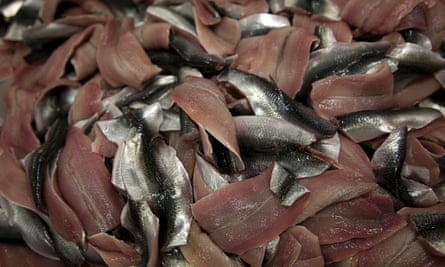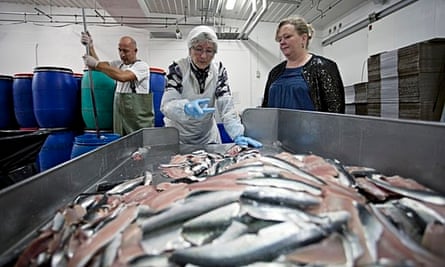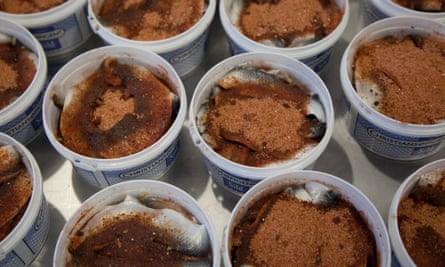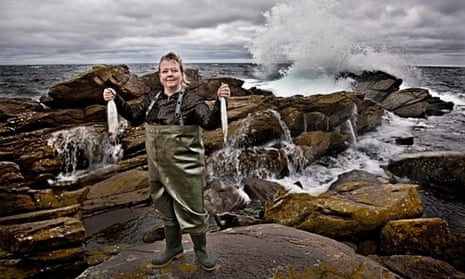An autumn storm is grumbling through the Baltic, the sky as dark and troubled as the sea. On the little Danish island of Bornholm, fresh herrings are being salted for the winter, as they have been for thousands of years, to keep humans going during the hungry months ahead. Kim Rømer and his five staff have been working since before dawn to get a tonne of the fish, newly caught in the Kattegat, into barrels of brine and vinegar while they are still firm and fresh.
Silla Bjerrum dips her finger into a brimming barrel to taste the curing liquid – she’s surprised by how strong it is. Danish by birth, Bjerrum is head chef and chief executive of Feng Sushi, a chain of inventive sushi restaurants in London that, since she co-founded it in 1999, has always promoted sustainable fish and the work of the Marine Stewardship Council. We’re here so she can see how sustainable herring might make it on to a sushi restaurant’s menu. “In traditional Japanese cuisine, every wild fish eaten raw, except tuna, is cured. That makes them healthy and brings out flavour,” she explains. “I want to take these Danish traditional cures and give them a Japanese twist.”
The little factory is so close to the sea, the storm-spray is marinating the roof. Inside, spices are packed into tubs of cured herring, all headed for Denmark’s Christmas tables, where sild is as crucial as mince pies. British people now know herring chiefly as kippers or tongue-curling pickles. But in the Nordic states, cured, spiced herring is a celebration food. Like air-cured ham in the mountains of Spain and Italy or potted shrimp in Morecambe bay, a processed food born of seasonal pressures and lack of refrigeration has become a treasured delicacy.

The Christiansøpigen cure that Bjerrum wants to track down makes something very different from the industrial-vinegar herring we get in Britain, skewered with a toothpick in jars marked Bismarck. Sweet, spicy, softly chewy to the bite and paprika-red, these are a treat. In the factory, we scoff them with Rømer’s staff for lunch. “If I tell you the recipe, I will have to kill you,” says Rømer, a former fisherman who bought the secret off its original owner for a million Danish krone (£100,000). “Only two people in the whole of Denmark know it.” But the overwhelming smell of clove and allspice as you enter the shed tells you a bit about what’s going on.
The story goes that in the 1890s, a Danish sailor returned from east Asia to Christiansø, a tiny herring-fishing island just off Bornholm, with a present for his sister. Curing the herring catch one day, she put aside the usual bay leaf and dill to try the packet of foreign spices her brother had brought – sandalwood, allspice, pepper, paprika and nutmeg. The recipe is the one Rømer bought, and now “herrings of the girl from Christiansø” are served in most of Denmark’s Michelin-starred restaurants, and sought out by food-hounds from across the world (you can buy them on a Danish-language site via tinyurl.com/nxvvlqm). In Danish shops, a 500g tub of Kim’s Christiansøpigen rød kryddersild sells for about £8.
From the middle ages on, herring and cod provided Atlantic Europe with most of its protein. But now, herrings are one of Britain’s lost foods. We used to call them the silver darlings. They were small and tasty, whether fried, smoked or cured, and full of the healthy oils we now buy in expensive food supplements. They are indeed silver, as slick and bright as mercury. They once existed in unbelievable abundance – the word herring comes from the Old German for “multitude”. In 1913, it was estimated that 10,000 boats from all over Europe fished herring in Scottish waters. At the peak of the herring boom, Britain exported a quarter of a million tonnes a year.

For the poorer people of Britain in the 19th and early 20th century, herring was absolutely crucial – tens of thousands of jobs and the nutrition of millions were dependent on the fish. For generations of young women, who travelled to work in the sea ports when the season was at its height, herring brought adventure, escape from home and a chance at an independent income. Scotland is full of songs about herring and recipes for cooking them: “caller” or fresh ones rolled in oatmeal and fried in dripping, potted in vinegar with a bay leaf, or the classic tatties and herring: salt herring slow-stewed with potatoes (far tastier than it sounds).
But though most of the herring now eaten in Scandinavia come from the North Sea, overfishing saw the collapse of the British North Sea herring fishery by the 1970s, and for four years it was banned completely. After many years of tight controls, the silver darlings may be at last returning. A small fishery based in Hastings in East Sussex, which has been certified as sustainable by the Marine Stewardship Council for 10 years, held its annual fair earlier this month, though it is permitted to catch just 10 tonnes a year. Five other revived herring fisheries around Britain and Ireland have recently been MSC-certified, and more are in the pipeline.
Bjerrum’s investigation paid off: the menu at Feng Sushi now features sashimi of herring and mackerel, cured in salt, sugar and rice vinegar , with shredded daikon, mirin and beetroot. But the recipe her eight-year-old daughter really likes merges the many northern herring cooking traditions: Scots, Danish and Japanese. She gently poaches the fish in soy sauce, water and daikon, then uses the liquid as the basis of a herring and soba noodle soup . “I want to see if I, a Japanese chef with Danish roots, can reinvent herring,” Bjerrum says. Her efforts are welcome – though most of us would just be happy to see the return of the silver darlings.

The Marine Stewardship Council has details of herring conservation efforts and some recipes.
Silla Bjerrum’s herring soba noodles
(Serves 4)
1 medium-sized daikon (also known as mooli), peeled and sliced into 1cm discs
30ml soy sauce
50ml mirin
1 tbsp hondashi (Japanese fish stock made from cured and smoked bonito)
1 tbsp honey
500ml water
1kg fresh spinach, washed and stalks removed
A kettle of boiling water
Salt, to season
200g dried soba noodles
8 fresh herring fillets, pinboned (preferably MSC-certified)
Freshly ground pepper, to season
4 spring onions, chopped extra-finely on the diagonal
Put the mooli pieces in a medium saucepan and add soy, mirin, hondashi, honey and 500ml water. Leave to simmer on a gentle heat for about 10-12 minutes, until the daikon is tender.
Put the spinach in a large bowl and pour over boiling water. Add a pinch of salt and leave to soak for 8-10 minutes, until blanched.
Put another saucepan on the stove, bring salty water to the boil and cook soba noodles for up to seven minutes, until al dente. Drain in a colander and rinse in cold water for one minute to add a nice shine to the noodles, then return to saucepan.
Drain the spinach of the hot water, leave in a colander for a few minutes, then squeeze out all of the liquid.
Unravel a large piece of cling film, add the spinach and roll into a chunky sausage shape to ensure all excess water has been squeezed out.
Add the herring to the daikon liquid and poach for for three minutes (handle the herring gently, as they break easily). Season with pepper, then take off the heat.
Using a ladle, pour all the poaching liquid over the noodles to reheat for one minute. Divide the noodles and liquid into four large bowls, and top up with boiling water so they are fully covered.
Unroll the spinach and cut into four portions. Add one to each bowl, plus two or three pieces of mooli and two herring fillets. Sprinkle with spring onions and serve.

Comments (…)
Sign in or create your Guardian account to join the discussion